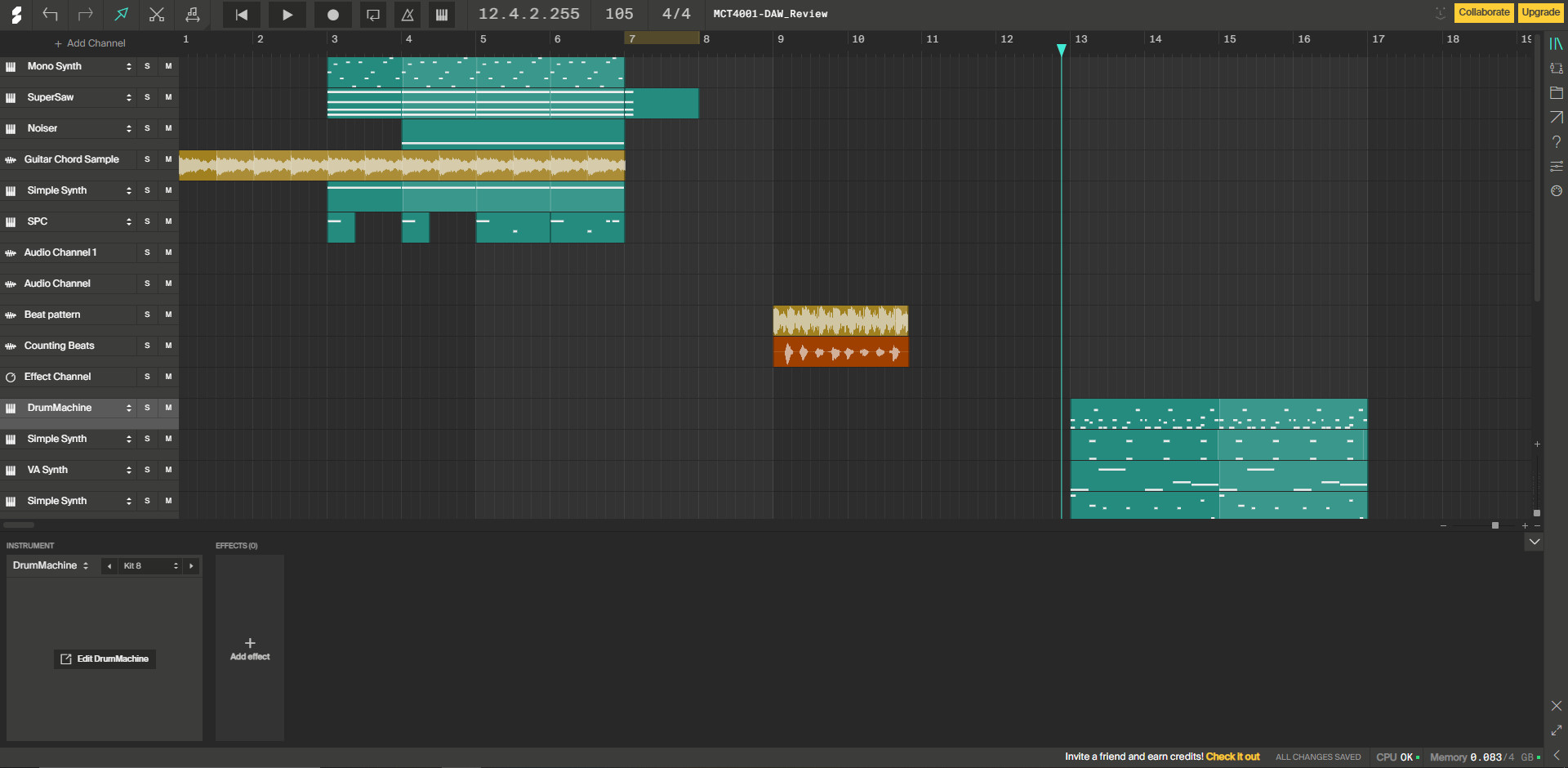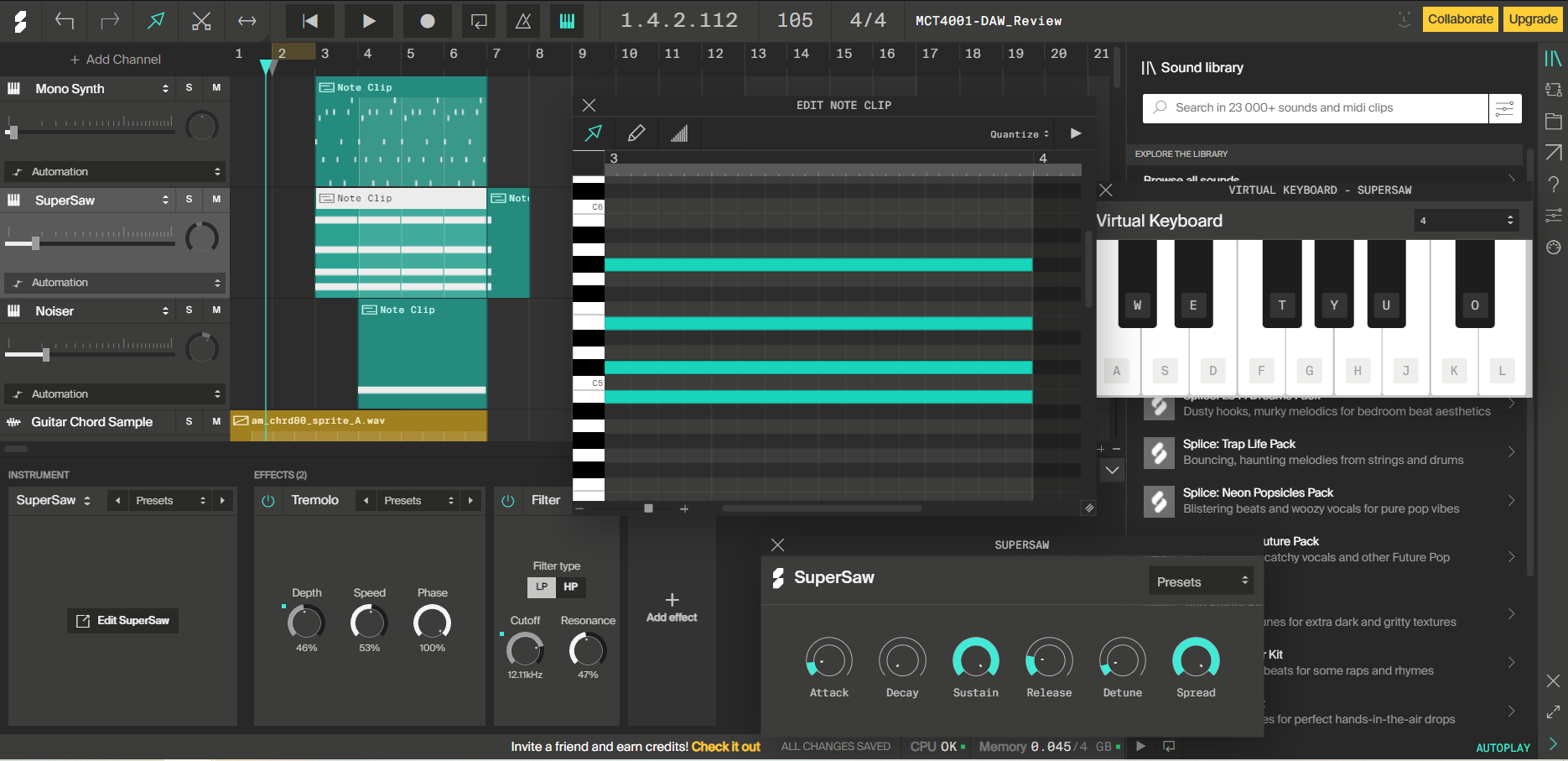Soundation Review: What to Expect
Overview
Soundation is a collaborative, online DAW which allows you to create music with people no matter the distance. We started a new Soundation project and created short segments of music to try out its different features. So without further ado, get ready for a preview of what the free version of Soundation can do, can’t do, and should do so you can decide if it’s for you before wasting your time or energy.

The Good
The first thing that you’ll notice when opening Soundation is it’s modern looking user interface. It is extremely easy on the eyes, we could work on it for hours with no issues. Interface control works as expected, with CTRL and SHIFT to toggle zooming and left-right scrolling with the mouse wheel respectively. Clicking and dragging along the header creates a looping region, but we haven’t found a shortcut to quickly loop around one or more regions yet.
Soundation deals with long dropdown menus in a great way: the dropdown menus scroll in the opposite direction of your mouse. It works wonders with lengthy automation lists.
Something we were concerned about, this being an online collaboration tool, was how Soundation deals with one user removing things another is working on like deleting a MIDI clip while it’s being edited, or changing an instrument while it’s settings are being tweaked. This too works like you’d expect: the clip disappears, and the instrument is replaced.
On the topic of editing someone else’s work, the undo/redo buttons are local to each user, not stored in the session. This means if someone deletes a clip you are working on, only they can undo to bring it back. In our opinion, this is intuitive and expected behavior, but we understand that some might want a global undo/redo function.
As of writing this review, Soundation has 12 instruments to choose from along with a whole bunch of samples, which allows the user to create fairly intricate music. If this is not enough for you, you can of course record directly into an audio track from your mic or add audio files from elsewhere.
Soundation is also well documented, and there are plenty of tutorials online, both videos and articles made by the developers.
TLDR;
- Great and intuitive UI and interface control. Easy on the eyes.
- Undo/Redo are local.
- Lots of instruments and sounds to work with.
The Bad
There is one UI behaviour which doesn’t work well, and that is moving tracks up the stack. The window does not automatically scroll upward, and so you have to drag and drop the track you want to move multiple times to get to the top. Clunky.
Something to note is that there is no way to rename instrument tracks yet. They are given the name of their instrument, which can get confusing when there are many instruments of the same type getting the same name. This is especially true since there is no track color coding either, though regions/clips can be colored. Tracks can also not be collapsed.
The piano roll opens in a new window, which we know is standard in some DAWs but the option to dock it would be nice to avoid clutter.

When inputting notes in a piano roll, we have a few concerns:
- Firstly, when adjusting a note’s position, the note will keep sounding until you stop clicking on it. It’s nice with a preview, but it gets old very quickly.
- And secondly, you can only enlarge or shorten a note from the ending of the note. To shorten a note from its beginning, you have to drag it back with your mouse, and then shorten it from the right.
Now on to music making: a critical flaw that we found when trying out Soundation is that, when recording with a microphone, the input is recorded with a fair amount of delay, even on the lowest buffer settings.
Despite what you might believe, we were not off beat. This issue forces you to manually adjust the recorded clip to match with other tracks, far from ideal.
An aspect in which we found Soundation to be very lacking is in the variety of filters, which is excessively limited compared to other offline DAWs of similar characteristics. Not to mention that they can only be applied to tracks, and not to individual clips, as it happens with automation. This was a bit disappointing since it really restricts your sound design options.
Some audio processing features we’re missing is the ability to synchronize sounds with the global tempo track (eg. LFOs) and pitch shifting, features we were looking for even early on. It doesn’t seem like Soundation supports CC messages at all, really.
TLDR;
- Limited color coding and track organization.
- No input signal monitoring.
- Input delay.
- No LFO sync.
- No CC.
Final Words
Some features are locked for free users, which is to be expected. The limitations for free users include:
- Only 3 projects.
- Flexible export options and high quality audio.
Still, here are some examples of what you can do with despite the limitations:
Overall, Soundation is a solid and fun collaboration tool for beginners and veterans alike, but it could do with a couple of quality-of-life improvements and deeper features.
